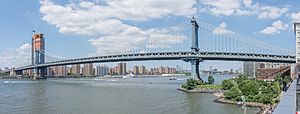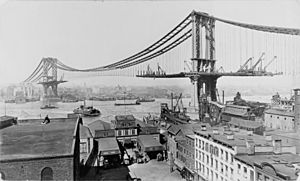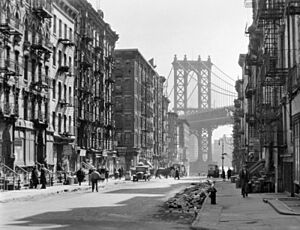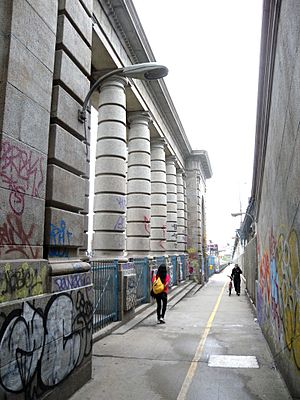Manhattan Bridge facts for kids
Quick facts for kids Manhattan Bridge |
|
|---|---|

Seen from Brooklyn in July 2017
|
|
| Coordinates | 40°42′25″N 73°59′26″W / 40.7070°N 73.9905°W |
| Carries | 7 lanes of roadway, 4 tracks of the |
| Crosses | East River |
| Locale | New York City (Manhattan-Brooklyn) |
| Maintained by | New York City Department of Transportation |
| ID number | 2240028 (upper) 2240027 (lower) |
| Characteristics | |
| Design | Suspension bridge |
| Total length | 6,855 ft (2,089 m) |
| Width | 120 feet (37 m) |
| Height | 336 ft (102 m) (towers) |
| Longest span | 1,480 feet (451 m) |
| Clearance below | 135 ft (41.1 m) |
| History | |
| Designer | Leon Solomon Moisseiff |
| Constructed by | Othniel Foster Nichols |
| Construction begin | 1901 |
| Construction end | 1912 |
| Opened | December 31, 1909 |
| Statistics | |
| Daily traffic | 85,084 (2016) |
| Toll | Free both ways |
The Manhattan Bridge is a suspension bridge in New York City. It crosses the East River. The bridge connects two parts of New York City: Manhattan and Brooklyn. It is about 6,855 ft (2,089 m) long.
The bridge opened on December 31, 1909. Leon Moisseiff designed it. Its design was very new back then. Many longer suspension bridges today use ideas from its design. The bridge is an official landmark. In 2009, it became a National Historic Civil Engineering Landmark.
Contents
About the Manhattan Bridge
The Manhattan Bridge has two levels. The top level has four lanes for cars. These lanes are split, with traffic going in opposite directions. The lower level has three lanes for cars. These lanes now only go towards Manhattan.
The lower level also has four subway tracks. Two tracks are under each of the upper roadways. There is a walkway on the west side for people. On the east side, there is a special path for bikes. The main part of the bridge is 1,480 feet (450 m) long.
History of the Bridge
The Manhattan Bridge was the last of three big suspension bridges built over the lower East River. The other two were the Brooklyn Bridge and the Williamsburg Bridge. At first, it was called "Bridge No. 3." But in 1902, it was named the Manhattan Bridge.
Building the Bridge
Work on the bridge's foundations started around 1901. In May 1904, $10 million was given to build the bridge. People expected construction to begin later that year.
Engineers decided to use strong wire cables for the bridge. The first temporary wire was put up in June 1908. This wire helped to guide the main cables. The main cables were very thick, about 21 inches (53 cm) each.
By this time, the cost to build the bridge had grown to $22 million. The bridge needed 30,000 tons of steel. The Phoenix Bridge Company built the steel parts. The first large steel beam was put in place in February 1909. By April, most of the bridge's main section was ready.
In 1905, a subway line was planned to cross the bridge. This plan was approved in 1907. Construction for the subway tracks started in 1908.
Opening Day and Early Years
On December 5, 1909, about 100 people from Brooklyn walked across the bridge. This showed that it was almost finished. The bridge officially opened on December 31, 1909. Mayor George B. McClellan Jr. opened it.
Soon after it opened, a fire on the Brooklyn side caused some damage. In 1910, plans were made for grand entrances to the bridge. These plans were part of the "City Beautiful" movement. The main arch and columns on the Manhattan side were finished in 1915.
Two large stone statues were put on the Brooklyn side in 1916. These statues were named "Brooklyn" and "Manhattan." Each was 12-foot-high (3.7 m).
In 1922, an upper roadway was added to the bridge. During the Cold War in 1951, lights and fences were added. These were to protect the bridge from possible attacks. The statues on the Brooklyn side were moved to the Brooklyn Museum in 1963. This was done to make the roadway wider.
Keeping the Bridge Strong
Subway trains crossing the bridge put a lot of stress on it. Over time, the bridge needed repairs. It has been fixed and updated many times. By 2001, 258 lights were put on the arch and columns.
The Bridge Today
The original walkway for people on the south side of the bridge reopened in June 2001. It had been closed for forty years. At first, bikes also used this path. But in 2004, a separate bike path opened on the north side.
In October 2009, the bridge celebrated its 100th birthday. There were many events, including a parade and fireworks. In 2009, the bridge was named a National Historic Civil Engineering Landmark. This was done by the American Society of Civil Engineers.
Images for kids
-
View down Pike Street toward the Manhattan Bridge, 1936, photograph by Berenice Abbott
-
The Greek Revival triumphal arch and colonnade at the Manhattan entrance
-
A Manhattan-bound D train of R68 cars crosses the bridge on the north tracks
See also
In Spanish: Puente de Manhattan para niños











